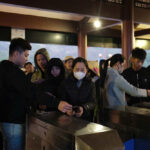The Minister of Culture, Sports, and Tourism has proclaimed the Tay Phuong Pagoda Traditional Festival a National Intangible Cultural Heritage. This annual event, held in Thach Xa Commune, Thach That District, Hanoi, is a vibrant celebration of culture and religion, featuring puppetry performances, rituals honoring Heaven and Earth, Buddhist traditions, and folk games.
| Vietnamese water puppetry, a form of folk art, is a beloved tradition at the annual Tay Phuong Pagoda Festival. This captivating performance, set against the backdrop of the pagoda, enchants audiences of all ages. Photo: Khanh Huy/ The Hanoi Times |
The festival, which takes place over the course of a month, begins at the start of the lunar year and reaches its peak on the 6th day of the 3rd lunar month. It is a time when the local community comes together to honor their cultural and spiritual heritage, with rituals and traditions that have been passed down through generations.
The recognition as a National Intangible Cultural Heritage is a testament to the Tay Phuong Pagoda’s significance. This distinction will help promote tourism and raise awareness of the pagoda’s rich history, allowing visitors to immerse themselves in the cultural and spiritual traditions of Vietnam.
The Tay Phuong Pagoda, also known as the Sung Phuc Pagoda, is located just 30 kilometers from the heart of Hanoi. With a history spanning over 1750 years, it is the second oldest pagoda in Vietnam after the renowned Dau Pagoda. In July 2022, the Prime Minister designated the pagoda as a special national relic, acknowledging its exceptional cultural and historical value.
| The Tay Phuong Pagoda Festival attracts visitors from near and far. It is a time when the pagoda comes alive with celebration and tradition, offering a unique glimpse into Vietnam’s cultural heritage. Photo: Khanh Huy/ The Hanoi Times |
Constructed in 1632 during the reign of King Le Than Tong, the Tay Phuong Pagoda underwent a complete renovation in 1794, taking on the name “Tay Phuong Ancient Pagoda” under the Tay Son Dynasty. The pagoda’s architecture is truly unique, with three one-story structures built in descending order on a hill, resembling a buffalo. The double-tiered roofs reflect Buddhist and Confucian influences, and the three buildings symbolize the three forces governing the world.
One of the most remarkable features of the Tay Phuong Pagoda is the collection of 72 exquisite wooden Buddha statues housed within the main hall. These statues, along with the pagoda’s architectural grandeur, make it a must-visit destination for those seeking to explore Vietnam’s cultural and spiritual heritage.
The Tay Phuong Pagoda, a place of cultural and spiritual significance, also offers visitors a glimpse into the peaceful village life of northern Vietnam. It stands as a testament to the country’s rich history and cultural traditions, welcoming visitors from near and far to experience its serene beauty and unique atmosphere.
Hanoi: The Crown Jewel of Asia’s Travel Destinations
Hanoi, Vietnam’s ancient capital with a rich history spanning centuries, has rightfully secured its spot on Lonely Planet’s ‘Ten Dream Trips to Take in Asia in 2025’. The city enthralls visitors with its abundance of historic pagodas and temples, offering a glimpse into its profound cultural heritage.










